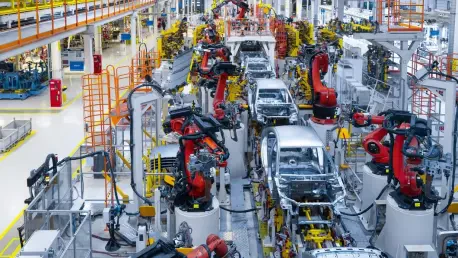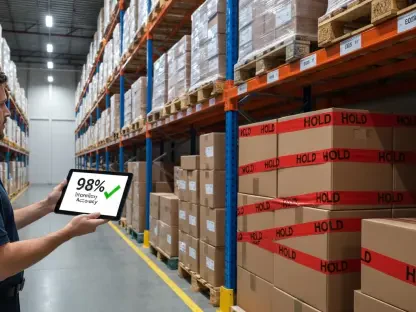Overview of Mexico’s Automotive Landscape
In a world where global supply chains are rapidly realigning, Mexico stands out as a powerhouse in the automotive industry, producing nearly 4 million vehicles in the past year alone, which underscores the nation’s pivotal role in North America’s manufacturing ecosystem. Driven by proximity to major markets and competitive advantages, Mexico has become a focal point for nearshoring as companies rethink their strategies amid geopolitical shifts, presenting both immense opportunities and complex challenges that demand attention.
The automotive sector in Mexico thrives as a critical hub, with major players like Volvo, BYD, Hyundai Mobis, and Renault establishing significant operations. Favorable trade agreements, such as the USMCA, coupled with cost-effective labor, have cemented the country’s position as a preferred destination for production. Moreover, the industry is witnessing a transformative shift toward electric vehicles (EVs), reflecting broader technological trends that are reshaping global markets.
This report delves into the dynamics propelling Mexico’s automotive growth, from nearshoring benefits to trade uncertainties. It examines key trends, data-driven projections, and persistent hurdles while offering insights into the future trajectory of this vital sector. The analysis aims to provide stakeholders with a comprehensive understanding of the opportunities and obstacles defining this vibrant industry.
Key Trends in Mexico’s Automotive Supply Chains
Nearshoring as a Competitive Edge
Mexico’s geographic proximity to the United States offers a distinct advantage, making it a prime location for nearshoring initiatives in the automotive sector. Ranking 13th on the Savills Nearshoring Index, the country benefits from lower transportation costs and quicker delivery times compared to distant manufacturing hubs. This strategic position has attracted substantial foreign investment, with global manufacturers expanding their footprint to capitalize on these efficiencies.
However, the nearshoring boom comes with its share of challenges that could impede progress if left unaddressed. Limited logistics infrastructure often creates bottlenecks, slowing the movement of goods across borders. Additionally, the availability of clean energy remains a concern as companies strive to meet sustainability goals, highlighting the need for targeted improvements to sustain this upward trajectory.
Foreign investments are pouring in, yet the pace of infrastructure development must accelerate to match this growth. Enhancing port facilities, road networks, and energy grids will be crucial to maintaining Mexico’s appeal as a nearshoring destination. Overcoming these hurdles could unlock even greater potential for the industry to flourish in the coming years.
Industry Performance and Projections
Recent data paints a promising picture, with vehicle production in Mexico achieving a robust 5.56% increase over the past year. This growth reflects the nation’s capacity to meet the escalating demand across North America, which requires around 16 million vehicles annually. Looking ahead, a steady rise of approximately 2.7% in output is anticipated for the current year, signaling sustained momentum.
The shift toward electrification is gaining traction, with forecasts indicating a significant uptick in EV production over the next few years. Foreign direct investment continues to flow into this space, as manufacturers recognize Mexico’s potential to become a leader in sustainable automotive solutions. This trend aligns with global priorities, positioning the country at the forefront of innovation.
These projections underscore Mexico’s critical role in shaping the future of automotive manufacturing in the region. As demand for greener technologies rises, the ability to adapt and invest in EV infrastructure will determine how effectively the industry capitalizes on emerging opportunities. The path forward appears bright, provided strategic planning remains a priority.
Obstacles Facing the Automotive Sector
The automotive industry in Mexico grapples with notable supply chain gaps that hinder its full potential. A shortage of local tier one and tier two suppliers, especially in specialized areas like aluminum processing and plastic injection, creates dependencies on external sources. This limitation affects the ability to meet regional content requirements under trade agreements, posing a risk to competitiveness.
Logistical constraints further complicate the landscape, particularly in cross-border trade where inefficiencies often arise. Congested freight corridors and outdated infrastructure slow down the movement of goods, increasing costs for manufacturers. Addressing these bottlenecks through modernized transport systems and streamlined customs processes is essential to alleviate pressure on supply chains.
Potential solutions lie in fostering local supplier development and adopting innovative logistics strategies such as freight consolidation. By building a stronger domestic network of component producers, Mexico can reduce reliance on imports and enhance resilience. Simultaneously, consolidating shipments at secure facilities near borders could cut expenses and improve visibility, offering a practical way to navigate current limitations.
Trade Policies and Regulatory Impacts
The USMCA, a cornerstone of North American trade, faces a pivotal review in July 2026, with significant implications for Mexico’s automotive sector. This evaluation will scrutinize rules of origin, labor standards, and regional content requirements, potentially reshaping supply chain strategies. Manufacturers must prepare for various outcomes, from renewal to revisions, that could alter operational frameworks.
U.S. tariffs on aluminum and steel add another layer of complexity, impacting cost structures and sourcing decisions. These levies have prompted companies to explore alternatives like Foreign Trade Zones to mitigate financial burdens. Adapting to such measures requires agility and foresight to maintain profitability amid fluctuating trade policies.
Compliance with evolving regulations remains paramount, alongside the need for cross-border collaboration. Issues like transshipment and forced labor must be tackled collectively to ensure ethical practices and safeguard market access. Strengthening partnerships across the region will be vital to navigating this uncertain regulatory environment effectively.
Future Prospects for the Industry
Mexico’s automotive sector is poised for innovation, with initiatives like the Olinia project aiming to produce affordable EVs by 2030. This ambitious plan seeks to create compact, cost-effective vehicles for diverse uses, from personal transport to last-mile delivery. Such efforts signal a shift toward domestic ingenuity, reducing reliance on foreign technologies.
Global trends, including electrification and sustainability, are set to influence market dynamics profoundly. As consumer preferences evolve, manufacturers in Mexico must prioritize greener production methods to stay competitive. Investing in renewable energy sources and advanced technologies will be key to aligning with these international shifts.
Localized production and increased national content offer promising growth areas for the future. By enhancing domestic capabilities, the industry can lower logistics costs and bolster economic impact. However, geopolitical and economic factors will continue to play a role, necessitating a proactive approach to adapt to changing conditions and seize emerging prospects.
Reflecting on Insights and Next Steps
Looking back, the exploration of Mexico’s automotive industry revealed a delicate balance between leveraging nearshoring advantages and confronting trade uncertainties that shape its path. The persistent gaps in local supplier networks stood out as a critical barrier, often limiting the ability to meet stringent regional content demands. These challenges, intertwined with logistical inefficiencies, painted a picture of an industry at a crossroads, striving for greater resilience.
Beyond these hurdles, the looming USMCA review emerged as a defining moment that tests strategic preparedness across the sector. The industry’s response to U.S. tariffs through innovative logistics solutions demonstrated adaptability, yet underscored the need for deeper systemic changes. Initiatives like Olinia hinted at a vision of self-reliance, though their execution remained a point of speculation amid ambitious timelines.
Moving forward, stakeholders should prioritize investment in local supplier ecosystems to strengthen supply chains and reduce external dependencies. Optimizing logistics through expanded freight consolidation and infrastructure upgrades offers a tangible solution to current bottlenecks. Engaging proactively in USMCA negotiations, alongside fostering cross-border alliances, will be crucial to secure favorable outcomes and ensure Mexico’s continued ascent as a leader in North American automotive manufacturing.









